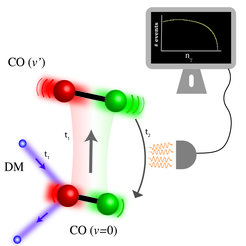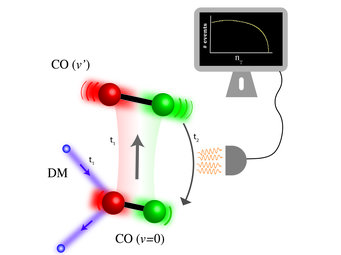Molecules as a Dark Matter Detector
We propose a novel direct detection concept to search for dark matter with masses in the 100 keV to 100 MeV range, in which the dark matter particles scatter off molecules in a gas and excite a vibrational and rotational state of the molecule. The excited ro-vibrational mode relaxes rapidly and produces a spectacular signal consisting of multiple infrared photons, which can be observed with ultrasensitive photodetectors.
Astrophysical and cosmological observations reveal the existence of dark matter at different scales through its gravitational effects on ordinary matter, however its identity is a mystery. Efforts to detect galactic dark matter particles in the laboratory are crucial for developing a more detailed understanding of the particle nature of dark matter. While the past decades have seen tremendous progress in direct-detection searches for Weakly Interacting Massive Particles (WIMP), which have masses above the proton, dark matter with masses below the proton are woefully underexplored, despite being theoretically well motivated.

We propose a novel direct detection concept to search for dark matter with masses in the 100 keV to 100 MeV range in which a dark matter particle scatters off a molecule and excites a ro-vibrational state of the molecule. The excited ro-vibrational mode relaxes rapidly and produces a spectacular signal consisting of multiple infrared photons that are, ultimately, detected. We discuss in detail carbon monoxide molecules, which enable efficient photon emission even at a relatively low temperature and high vapor pressure, and provide sensitivity to both spin-independent interactions and spin-dependent interactions with the neutron. We also consider various hydrogen halides and metal hydrides molecules, which provide sensitivity to spin-dependent interactions with the proton.
The proposed detection concept draws on recent advances in particle theory, AMO theory, molecular spectroscopy, and photodetector technology, to allow for the near-term exploration of orders of magnitude of new dark matter parameter space. This research is the result of an international collaboration between researchers of Princeton University, Berkeley University, Stony Brook University, and the group of theoretical AMO physics of the molecular physics department of the Fritz Haber Insitute.












